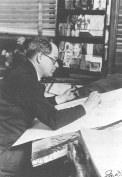
J. N. "Ding" Darling working in his studio
The beginnings of the The Cooperative Fish and Wildlife Research Unit Program were initiated in Iowa by the cartoonist, political satirist, and conservationist J. N. "Ding" Darling. In the early 1930s, Darling was the commissioner of the Iowa Fish and Game Commission when he created the cooperative wildlife research unit as a joint venture of Iowa State College and the Iowa Fish and Game Commission.
In 1934 Darling was appointed director of the Federal Bureau of Biological Survey. In this position, Darling lobbied Congress for support of a nationwide cooperative wildlife research unit program. With commitments from land-grant universities, state natural resources agencies, and ammunition companies, units were established in nine states that represented the breadth of ecosystems across the country (Oregon, Utah, Texas, Iowa, Maine, Connecticut, Virginia, Alabama, Ohio). Other states' interest in cooperative units exceeded available funds, but in 1938 a unit was added to the forestry program at Pennsylvania State University.
The Cooperative Units Act (P.L. 86-686) was passed by Congress in 1960, which authorized the unit program as a separate budget item within the U.S. Fish and Wildlife Service. This act also established cooperative fishery units, in which the Pennsylvania fishery unit was formed in 1964. The Cooperative Fish and Wildlife Program has evolved over the years, but probably the most significant changes were the combining of wildlife and fisheries programs at universities into single units in the 1970s, and moving the unit program from the U.S. Fish and Wildlife Service to the U.S. Geological Survey in the 1990s.
The Cooperative Fish and Wildlife Research Units are truly cooperative ventures of federal and state governments, and non-governmental organizations. For example, the Pennsylvania Cooperative Fish and Wildlife Research Unit is a joint venture of the U.S. Geological Survey, Pennsylvania Game Commission, Pennsylvania Fish and Boat Commission, The Department of Ecosystem Science and Management at The Pennsylvania State University, U.S. Fish and Wildlife Service, and the Wildlife Management Institute. At the Pennsylvania Unit, the Game Commission and the Fish and Boat Commission provide annual base funding, which is used to conduct research projects designed in conjunction with the state agencies. The Pennsylvania State University provides clerical staff and office support, as well as office, laboratory, and storage space for the Unit. The Biological Resources Division, U.S. Geological Survey provides funding for three full-time biologists who constitute the permanent Unit staff. The Wildlife Management Institute works to ensure continued national legislative support for the Unit program and provides monetary support to Units on an irregular basis.
The Cooperative Units have three facets to their mission:
Education - Cooperative Unit scientists teach university courses at the graduate level, provide academic guidance to graduate students and serve on academic committees.
Research - Cooperative Unit scientists conduct research that is designed to meet the information needs expressed by Cooperators of the Unit.
Technical Assistance - Units provide technical assistance and training to State and Federal personnel and other natural resource managers. The expertise of the Cooperative Research Unit scientists, cooperating university faculty and biologists of the cooperating State natural resource agency are made available for this aspect of the mission.
The mission of the Pennsylvania Cooperative Fish and Wildlife Research Unit is:
"... to conduct interdisciplinary applied and basic research in fish and wildlife management and contribute to graduate education. The Unit's research emphasis is on (1) integrating ecology and management of terrestrial and aquatic habitats, (2) evaluating the effects of human activities on wildlife, fish, and their habitats, and (3) providing guidelines for restoring and maintaining important terrestrial and aquatic communities. Unit personnel contribute to graduate education by engaging graduate students in research projects and teaching graduate level courses."
Abbreviated timeline of the PA Fishery and Wildlife Units
Cooperative Wildlife Research Unit (created in 1938)
Unit Leaders:
- Logan J. Bennett, 1938-43, 1945-47
- Pennoyer F English (acting) 1943-45
- Ward M. Sharp, 1948-62
- James S. Lindzey, 1962-80
- Gerald L. Storm (acting), 1980-82
Assistant Unit Leaders:
- Pennoyer F. English, 1938-58
- H. Norton Cope, 1958-1959
- John L. George, 1963-69
- Charles T. Cushwa, 1969-71
- Gerald L. Storm, 1972-80
Cooperative Fishery Research Unit (created in 1964)
Unit Leaders:
- Robert L. Butler, 1963-80
- Dean E. Arnold (acting) 1980-82
Assistant Unit Leaders:
- Anthony Bodola, 1964-67
- Donald C. Hales, 1967-69
- Robert F. Raleigh, 1970-72
- Dean E. Arnold, 1973-80
Cooperative Fish and Wildlife Research Unit (created in 1982)
Unit Leaders:
- Gerald L. Storm/Dean E. Arnold (acting co-leaders) 1982-84
- Robert F. Carline, 1984-2007 (fisheries)
- Duane R. Diefenbach, 2007-present (wildlife)
Assistant Unit Leaders:
- Gerald L. Storm, 1984-1997 (wildlife)
- Dean E. Arnold, 1984-1999 (fisheries)
- Erin M. Snyder, 2001-03 (fisheries)
- Duane R. Diefenbach, 1999-2007 (wildlife)
- Tyler Wagner, 2008-present (fisheries)
- W. David Walter, 2011-present (wildlife)

